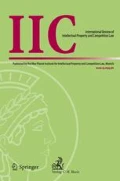-
1.
Works of applied art are excluded from the application of a rental and lending right.
-
2.
Section 16a of the Copyright Act does not regulate an independent copyright exploitation right. Rather, this provision refers only to the exhaustion of rights under Sec. 16(3) of the Copyright Act and provides for special rules for the case that the right holder rents or lends the copy of the work.
-
3.
Section 18a of the Copyright Act does not restrict the right of making available to certain categories of works or to two-dimensional works. Such an interpretation likewise is not in conformity with the wording of Sec. 18a of the Copyright Act, which speaks only of a work in general.
-
4.
For an infringement of the right pursuant to Sec. 18a of the Copyright Act it is accordingly not necessary for third parties to be given the possibility of putting the work to practical use (by using the piece of furniture).
-
5.
The publishing of a photograph on the Internet in which a reproduction of the protected sofa is clearly recognisable, makes the work with its artistic value available to third parties and thus infringes the copyright of the author according Sec. 18a Copyright Act.
-
6.
In general the requirement of sensory perceptibility for an infringement of copyright requires only that the creative design elements of a work are adopted. This is also true of the infringement of the right of making available: an offence is given when the work in the form used is perceptible, that is, when it very nearly conveys the sensory impression of the original work in its essential creative elements.
-
7.
On the one hand, the parody’s antithetical treatment requires a targeted adoption and distortion of essential features of the parodied work, so that a disturbance, if not a distortion, is as a rule to be affirmed. On the other hand, it is made clear to the viewer that the parody is precisely not a product of the author of the parodied work, but stems from the freedom of opinion and expression of the parodist.
Author information
Consortia
Additional information
Translation by Allison Felmy.
Rights and permissions
About this article
Cite this article
Copyright Act, Secs. 16, 16a, 18a. “Le Corbusier”. IIC 49, 106–112 (2018). https://doi.org/10.1007/s40319-017-0657-z
Published:
Issue Date:
DOI: https://doi.org/10.1007/s40319-017-0657-z

